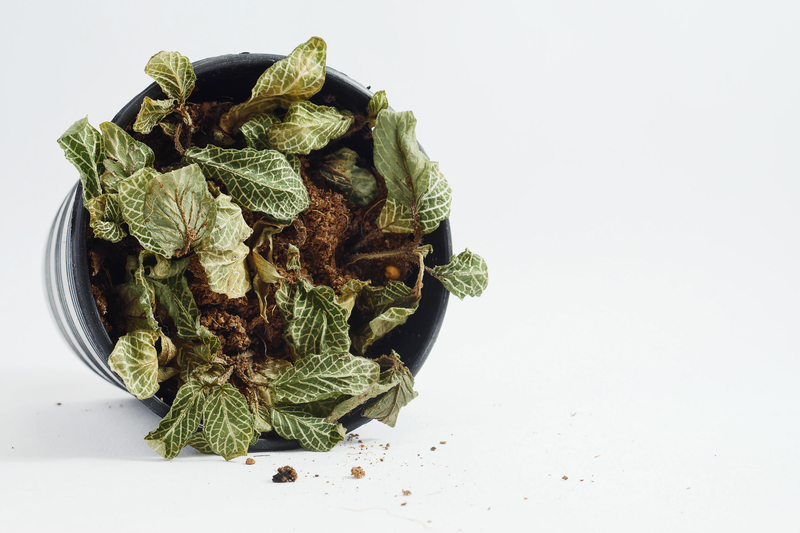Herb Garden Mastery: From Seed to Sprout
Posted on 25/05/2025
Herb Garden Mastery: From Seed to Sprout
Discover the rewarding journey of cultivating your personal oasis of fragrant, flavorful herbs--from selecting the right seeds to savoring your own homegrown harvest. Unlock the art and science behind herb garden mastery, whether you're a beginner or a seasoned green thumb.
Why Grow Your Own Herb Garden?
Growing your own herb garden offers numerous benefits beyond just fresh flavors. Homegrown herbs are more fragrant, cost-effective, and environmentally friendly than store-bought alternatives. Additionally, tending to a herb garden--from seed to sprout--provides a sense of accomplishment and therapeutic value.
- Superior Flavor: Freshly picked herbs transform any dish.
- Health Benefits: Many herbs contain antioxidants, vitamins, and minerals.
- Eco-Friendly: Reduces packaging waste and transportation emissions.
- All-Year Supply: Indoor gardening allows you to harvest even in winter.
- Ornamental Value: Herb gardens beautify both kitchens and landscapes.

Choosing the Best Herbs for Your Garden
The success of your herb garden begins with selecting the right herbs. Consider your local climate, sunlight availability, and culinary preferences. Some herbs are easier for beginners, while others require specific care.
Perennial vs. Annual Herbs
- Perennial Herbs: Survive winter and grow back each spring (e.g., thyme, chives, mint, oregano).
- Annual Herbs: Complete their life cycle in one season (e.g., basil, cilantro, dill).
Top 10 Easy-to-Grow Herbs for Beginners
- Basil: Ideal for summer gardens and sunny windowsills.
- Oregano: Hardy and versatile for Mediterranean dishes.
- Chives: Excellent in salads, omelets, and as garnishing.
- Mint: Thrives in containers to prevent spreading.
- Rosemary: Prefers well-drained soil and full sun.
- Parsley: Adds freshness to countless recipes.
- Cilantro: Essential for salsas and curries.
- Dill: Pairs perfectly with fish and potatoes.
- Sage: Great for seasoning roasts and stews.
- Thyme: A flavor-packed, resilient herb.
Starting Your Herb Garden: A Step-by-Step Guide
Step 1: Selecting Containers or Planting Beds
Herbs can flourish in both outdoor beds and indoor containers. For herb garden mastery, you'll need:
- Pots and Containers: At least 6 inches deep with good drainage holes.
- Raised Beds: Offer better soil control and weed management.
- Window Boxes: Perfect for kitchen herbs within arm's reach.
Step 2: The Right Soil Mix
Well-draining soil is critical for healthy herbs. Use a mix of:
- High-quality potting mix
- Compost for nutrients
- Perlite or sand for improved drainage
Step 3: Sowing Seeds for Success
For true herb garden mastery, learn how to start herbs from seed rather than transplants. Seeds are more economical and offer a wider variety. Here's how:
- Read Packet Instructions: Each herb has unique requirements for light and spacing.
- Use Seedling Trays: Fill with moistened seed-starting mix.
- Sow Seeds: Plant at the recommended depth--usually 2-3 times as deep as the seed's width.
- Cover Lightly: Some seeds (like basil) need light to germinate; cover with a thin layer of soil if required.
- Mist Gently: Use a spray bottle to keep soil damp, not soggy.
- Maintain Warmth: Most seeds sprout best at 65-75?F (18-24?C).
Step 4: Ensuring Proper Light and Temperature
- Sunlight: Most herbs need 6-8 hours of sun; supplement with grow lights indoors.
- Rotation: Turn pots regularly for even growth.
- Ventilation: Good air circulation prevents fungal diseases.
From Sprout to Thriving Herb Plant
Thinning and Transplanting Seedlings
After germination, many seedlings compete for space and nutrients. For robust growth:
- Thin Seedlings: Remove weaker sprouts to prevent overcrowding.
- Transplant Carefully: Move strong seedlings to individual pots or outdoor beds when they have 2-3 true leaves.
- Harden Off: Gradually acclimate indoor-grown plants to outdoor conditions over a week.
Watering Wisdom
- Consistent Moisture: Keep soil consistently moist for young herbs, but avoid overwatering.
- Drainage: Always ensure pots have drainage holes to prevent root rot.
- Mulching: Use straw or bark mulch to conserve moisture in outdoor beds.
Feeding and Nutrient Boosting
While herbs aren't heavy feeders, they benefit from:
- Monthly Fertilizing: Apply a diluted liquid fertilizer or compost tea.
- Avoid Overfertilizing: Excess fertilizer can reduce aromatic oils and flavor.
Herb Garden Mastery: Maintenance and Troubleshooting
Pruning and Harvesting for Healthy Growth
- Regular Pinching: Pinch off the top leaves to encourage bushier growth and prevent flowering.
- Harvesting: Always harvest from the top and take no more than a third of the plant at once.
- Remove Flowers: For most herbs, cut back flowers to maintain leaf production.
Pest and Disease Control
Common threats to your herb garden include:
- Aphids: Blast off with water or use insecticidal soap.
- Fungal Diseases: Ensure proper spacing and air circulation.
- Slugs and Snails: Use crushed eggshells or copper tape as barriers.
Companion Planting for Herb Garden Success
Some herbs improve the growth of their neighbors or repel pests:
- Basil: Repels aphids and enhances tomato growth.
- Chives: Discourage carrot flies and aphids.
- Rosemary: Deters cabbage moths.
- Dill: Attracts beneficial insects like ladybugs.
Expanding Your Herb Garden: Indoors & Outdoors
Indoor Herb Garden Mastery
Indoor herb gardens flourish on sunny windowsills, in hanging planters, and under grow lights. Perfect for apartment dwellers and year-round harvesting, indoor herbs like basil, parsley, and mint can be cultivated with just a few basic supplies.
- Window Placement: Choose south-facing for maximum light.
- Self-Watering Planters: Help maintain consistent moisture.
- Rotate Regularly: Prevents leggy, one-sided growth.
Outdoor Herb Garden Crafting
Outdoor gardens offer space and sun for sprawling varieties like sage and oregano. Raised beds, vertical gardens, and traditional rows all work well. Prepare your site by ensuring well-drained soil and watering access.
- Raised Beds: Improve drainage and warm soil faster in spring.
- Companion Planting: Plant herbs near vegetables to boost garden health.
- Mulching: Retains moisture and deters weeds.
Harvesting, Preserving, and Using Your Homegrown Herbs
Optimal Harvest Times
For peak flavor, harvest herbs just before flowering, in the cool morning after dew has dried. Use clean scissors to trim stems and leaves--never taking more than a third of the plant at a time.
Methods to Preserve Fresh Herbs
- Drying: Tie in bundles and hang upside down in a dry, dark place.
- Freezing: Chop and freeze in ice cube trays with a bit of water or oil.
- Infusions: Make herbal vinegars, oils, and butters for unique flavors.
Creative Uses for Homegrown Herbs
- Culinary: Enhance recipes from salads and soups to teas and desserts.
- Medicinal: Use for soothing teas, balms, and homemade remedies (always consult a professional first).
- Aromatic: Craft sachets, potpourri, or natural cleaning products.
Common Questions About Herb Garden Mastery
How Long Does It Take Herbs to Sprout?
Germination time varies by herb. Basil takes 5-10 days, while rosemary can take 2-3 weeks. Always consult seed packets and be patient; some perennials are slower to sprout but worth the wait.
Which Herbs Grow Well Together?
Most Mediterranean herbs--rosemary, thyme, sage, and oregano--prefer similar conditions and can be grown together. Mint should be kept in its own pot due to its aggressive spreading habit.
Do I Need to Fertilize My Herb Garden?
Herbs do not require heavy feeding. A monthly dose of compost or diluted organic fertilizer is usually sufficient. Overfertilizing leads to lush plants with less flavor.

Herb Garden Mastery: Tips for Year-Round Success
- Succession Planting: Plant new seeds every few weeks for a continuous supply.
- Label Plants: Use markers to keep track of different herb varieties.
- Monitor Pests: Regularly check for insects or disease.
- Use Rainwater: Herbs prefer non-chlorinated water if possible.
- Continue Learning: Join local gardening groups or online forums for shared advice.
Conclusion: Achieve Herb Garden Mastery From Seed to Sprout
Mastering the art of herb gardening is an enriching journey that transforms small seeds into thriving sprouted gardens, offering beauty, aroma, and flavor for your home and table. By starting with quality seeds, nurturing sprouts with proper care, and continuously learning, you'll cultivate not just herbs, but gardening skills that last a lifetime. Embrace herb garden mastery--from seed to sprout, every step brings you closer to homegrown abundance!
Ready to begin? Dig in, experiment, and enjoy every fresh, fragrant moment in your very own herb garden!

